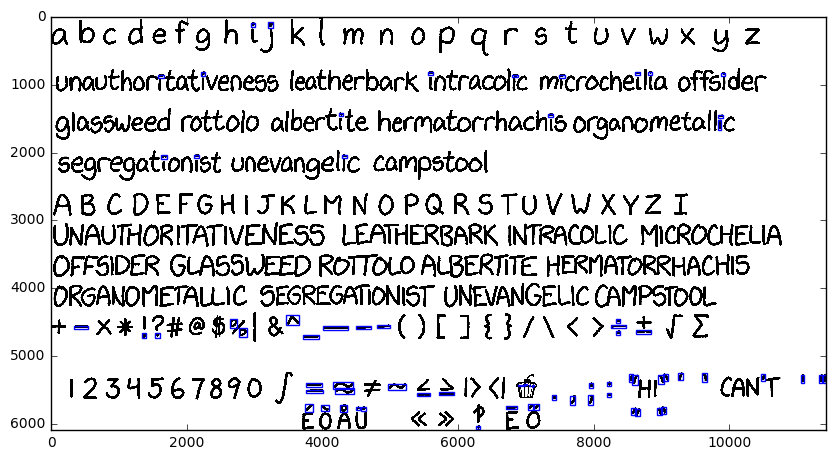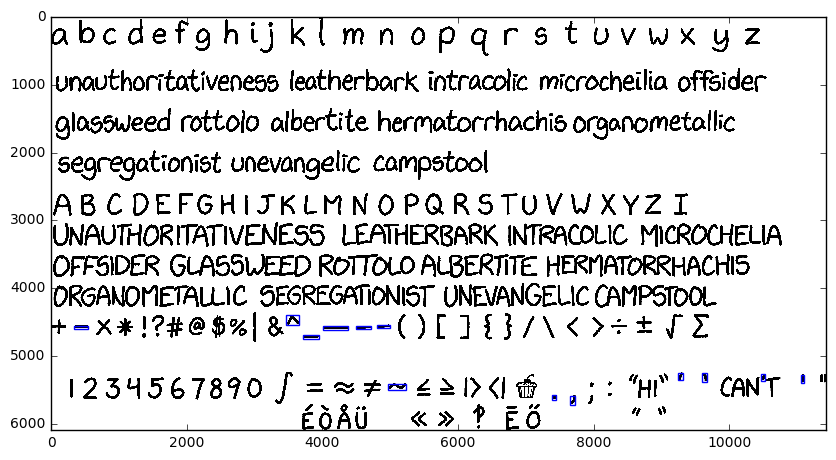In part one of XKCD font saga I gave some background on the XKCD handwriting dataset, and took an initial look at image segmentation in order to extract the individual strokes from the scanned image. In this instalment, I will apply the technique from part 1, as well as attempting to merge together strokes to form (some of) the glyphs desired.
I'm going to pay particular attention to "dotted" glyphs, such as "i", "j", ";" and "?". I will need to do future work to merge together non-dotted glyphs such as the two arrows from "≫", as these are indistinguishable from two characters that happen to be close to one another.
If you'd like to follow along, this notebook and the handwriting file may be found at https://gist.github.com/pelson/b80e3b3ab9edbda9ac4304f742cf292b.
We start by using the technique from part one to segment the images into individual strokes.
import matplotlib.pyplot as plt
from skimage.color import rgb2gray
import scipy.ndimage.measurements
from skimage import measure
import numpy as np
from scipy import ndimage as ndi
handwriting_img = plt.imread('handwriting_minimal.png')
handwriting_img_gray = rgb2gray(handwriting_img)
labels, _ = ndi.label(handwriting_img_gray < 1)
stroke_locations = measure.regionprops(labels)
Using this information, we create an image array that isolates the label, and use the sub-image's bounding box as a lookup:
bbox_to_stroke_img = {}
for stroke in stroke_locations:
# [miny, minx, maxy, maxx] (I don't know why its that way around...)
bbox = stroke.bbox
# Construct a slice that can be used to pick out this bounding box from
# the full image.
full_index = [slice(bbox[0], bbox[2]), slice(bbox[1], bbox[3])]
# Pick out the sub-image, and take a copy so that we can modify it without
# modifying the original.
stroke_img = handwriting_img[full_index + [Ellipsis]].copy()
# Using the "labels" array, produce a binary mask that is True for every
# pixel that is marked as this label, and False otherwise.
stroke_mask = labels[full_index] == stroke.label
# For each color channel, use the mask to maintain the full image pixels that
# are part of this stroke. Where a pixel remains that is not part of this stroke,
# replace it with 1 (ultimately making it white).
for channel in range(3):
stroke_img[:, :, channel] = np.where(stroke_mask, stroke_img[:, :, channel], 1)
# Convert the image to an RGB byte array.
stroke_img = (stroke_img * 255).astype(np.uint8)
bbox_to_stroke_img[bbox] = stroke_img
Pick off potentially wide, but not high, strokes - these are our dots and lines that we may want to merge together (though not in all cases - we do want some punctuation glyphs to remain!).
stroke_merge_contenders = {}
for bbox, img in bbox_to_stroke_img.items():
height = bbox[2] - bbox[0]
width = bbox[3] - bbox[1]
if width < 450 and height < 150:
stroke_merge_contenders[bbox] = img
Great. Let's do some work to take a look at these images in the notebook. Essentially, the easiest approach is to convert the images to base64 PNGs, and display them in raw HTML. I also want the images to display inline so that I can show many images at once.
from IPython.display import display, HTML
from io import BytesIO
import PIL
import base64
def html_float_image_array(img, downscale=5, style="display: inline; margin-right:20px"):
"""
Generates a base64 encoded image (scaled down) that is displayed inline.
Great for showing multiple images in notebook output.
"""
im = PIL.Image.fromarray(img)
bio = BytesIO()
width, height = img.shape[:2]
if downscale and (width > downscale ** 2 and height > downscale ** 2):
im = im.resize([height // downscale, width // downscale],
PIL.Image.ANTIALIAS)
im.save(bio, format='png')
encoded_string = base64.b64encode(bio.getvalue())
html = ('<img src="data:image/png;base64,{}" style="{}"/>'
''.format(encoded_string.decode('utf-8'), style))
return html
Using this new function on our stroke_merge_contenders:
display(HTML(''.join(html_float_image_array(img)
for bbox, img in stroke_merge_contenders.items())))
Now, let's take a look at the bounding boxes of these marks, so that we can get some intuition about what we have picked out:
import matplotlib.pyplot as plt
import matplotlib.patches as mpatches
plt.figure(figsize=(10, 10))
ax = plt.axes()
ax.imshow(handwriting_img)
for bbox, img in stroke_merge_contenders.items():
height = bbox[2] - bbox[0]
width = bbox[3] - bbox[1]
rect = mpatches.Rectangle([bbox[1], bbox[0]], width=width, height=height,
facecolor='none', edgecolor='blue')
ax.add_patch(rect)
plt.show()
This looks promising. Let's try to merge the chosen images to other, suitably close, strokes. In all situations, we want to allow a reasonable y distance, and a small x distance (e.g. consider the strokes for a speech mark ").
First, define the function that can actually do the merging of two images for us. We will have two image arrays and two bounding boxes, and we want to come up with a single image array and bounding box.
def merge_images(img1, img1_bbox, img2, img2_bbox):
"""
A function to merge together two images with different bounding boxes.
"""
# The new image bounding box.
bbox = (min([img1_bbox[0], img2_bbox[0]]),
min([img1_bbox[1], img2_bbox[1]]),
max([img1_bbox[2], img2_bbox[2]]),
max([img1_bbox[3], img2_bbox[3]]))
# The new image shape.
shape = (bbox[2] - bbox[0], bbox[3] - bbox[1], 3)
# The slice for image 1 inside of the new image array.
img1_slice = [slice(img1_bbox[0] - bbox[0], img1_bbox[2] - bbox[0]),
slice(img1_bbox[1] - bbox[1], img1_bbox[3] - bbox[1])]
# The slice for image 2 inside of the new image array.
img2_slice = [slice(img2_bbox[0] - bbox[0], img2_bbox[2] - bbox[0]),
slice(img2_bbox[1] - bbox[1], img2_bbox[3] - bbox[1])]
# Construct the new image, and fill it with white.
merged_image = np.empty(shape, dtype=np.uint8)
merged_image.fill(255)
# Use all of image 1 and just drop it into the correct location within the new image.
merged_image[img1_slice] = img1
# We can't use the same approach for image 2, as it potentially overlaps with image 1.
# Instead we use the parts of image 2 that aren't at the maximum of each color channel.
merged_image[img2_slice] = np.where(img2 != 255, img2,
merged_image[img2_slice])
return merged_image, bbox
This function probably also exists within skimage. Now that we have the ability to merge together images, let's define some functions that will help us measure the distance between potential images.
def min_interval_distance(interval_1, interval_2):
"""
Calculate the distance between two intervals.
>>> min_interval_distance([0, 1], [2, 3])
1
>>> min_interval_distance([0, 1], [0.5, 3])
0
>>> min_interval_distance([10, 11], [5, 8])
2
>>> min_interval_distance([10, 11], [8, 5])
2
There is so much room for more elegance here, but hey-ho...
"""
interval_1_sorted = sorted(interval_1)
interval_2_sorted = sorted(interval_2)
min_distance = min([np.abs(i_1 - i_2) for i_1 in interval_1 for i_2 in interval_2])
within_1 = any(interval_1_sorted[0] <= i_2 <= interval_1_sorted[1] for i_2 in interval_2)
within_2 = any(interval_2_sorted[0] <= i_1 <= interval_2_sorted[1] for i_1 in interval_1)
if within_1 or within_2:
min_distance = 0
return min_distance
def max_interval_distance(interval_1, interval_2):
"""
Calculate the distance between two intervals.
>>> max_interval_distance([0, 1], [2, 3])
3
>>> max_interval_distance([0, 1], [0.5, 3])
3
>>> max_interval_distance([10, 11], [5, 8])
6
>>> max_interval_distance([10, 11], [8, 5])
6
There is so much room for more elegance here, but hey-ho...
"""
max_distance = max([np.abs(i_1 - i_2) for i_1 in interval_1 for i_2 in interval_2])
return max_distance
def contains(interval_1, interval_2):
"""
Whether one bounding box entirely contains another
>>> contains([0, 4], [2, 3])
True
>>> contains([0, 1], [0.5, 3])
False
>>> contains([2, 3], [4, 0])
True
"""
interval_1_sorted = sorted(interval_1)
interval_2_sorted = sorted(interval_2)
within_1 = all(interval_1_sorted[0] <= i_2 <= interval_1_sorted[1] for i_2 in interval_2)
within_2 = all(interval_2_sorted[0] <= i_1 <= interval_2_sorted[1] for i_1 in interval_1)
return within_1 or within_2
# Check the function actually works...
import doctest; doctest.testmod()
A neat trick from the functions above is that I did all of my development in the notebook by starting with function stubs, docstrings and doctests. Only then did I begin to gradually fill in the functionality. I don't often do development in the notebook, but in situations where it makes sense, the doctest technique I've used is an approach that allows you to write testable code in the notebook fairly easily.
Now for the hard work - we want to look at each of the stroke_merge_contenders and find potential pairs of images that may be merged. No doubt the metrics themselves to determine "suitable" pairs will require some development iteration.
from collections import OrderedDict, namedtuple
Metric = namedtuple('Metric', ['maxx', 'maxy', 'minx', 'miny', 'withinx', 'withiny'])
# Track the images that ultimately got merged.
images_that_were_mergers = []
# Track the images that didn't find a merge buddy.
images_that_didnt_get_merged = []
# Take a copy of our existing images - we will remove merged strokes from here, and replace
# with the composite.
merged_bbox_to_stroke_img = bbox_to_stroke_img.copy()
# We could use an RTree for efficient nearest neighbour lookup, but just use a greedy search for now.
reduced_stroke_merge_contenders = stroke_merge_contenders.copy()
while reduced_stroke_merge_contenders:
bbox, img = reduced_stroke_merge_contenders.popitem()
# If we have already processed this file (as the right hand pair of a merge) then skip it.
if bbox not in merged_bbox_to_stroke_img:
continue
# Remove this image from the final glyph set.
merged_bbox_to_stroke_img.pop(bbox, None)
candidates = []
for other_bbox, other_img in list(merged_bbox_to_stroke_img.items()):
if other_bbox == bbox:
# We don't want to merge with ourselves.
continue
x_range, x_range_other = [other_bbox[1], other_bbox[3]], [bbox[1], bbox[3]]
minx = min_interval_distance(x_range, x_range_other)
miny = min_interval_distance([other_bbox[0], other_bbox[2]], [bbox[0], bbox[2]])
maxx = max_interval_distance([other_bbox[1], other_bbox[3]], [bbox[1], bbox[3]])
maxy = max_interval_distance([other_bbox[0], other_bbox[2]], [bbox[0], bbox[2]])
withinx = contains([other_bbox[1], other_bbox[3]], [bbox[1], bbox[3]])
withiny = contains([other_bbox[0], other_bbox[2]], [bbox[0], bbox[2]])
metric = Metric(minx=minx, miny=miny, maxx=maxx, maxy=maxy, withinx=withinx, withiny=withiny)
# The condition for which a pair of glyphs will be consiered for merging.
# This took a significant amount of iteration to get a good performance.
if (withinx and withiny) or \
(((maxx < 250 or minx == 0) and minx < 10) and miny < 50) or \
(other_bbox in reduced_stroke_merge_contenders and minx == 0 and maxy < 350):
candidates.append([metric, other_bbox, other_img])
if not candidates:
images_that_didnt_get_merged.append([img, bbox])
# Put the stroke back into the new_bboxes so that we don't loose it.
merged_bbox_to_stroke_img[bbox] = img
else:
# Prefer the candidates with a small maximum x over anything else.
candidates.sort(key=lambda candidate: (candidate[0].maxx, candidate))
metric, other_bbox, other_img = candidates[0]
merged_image, merged_bbox = merge_images(img, bbox, other_img, other_bbox)
# We're done with the other image too - remove it from the results.
merged_bbox_to_stroke_img.pop(other_bbox)
# If the resulting image is *tiny* then consider putting it back
# into the pool of items that may be merged. This really is only of
# value to the sprinkles within the cupcake.
height = merged_bbox[2] - merged_bbox[0]
width = merged_bbox[3] - merged_bbox[1]
if width < 100 and height < 100:
reduced_stroke_merge_contenders[merged_bbox] = merged_image
images_that_were_mergers.append(merged_bbox)
merged_bbox_to_stroke_img[merged_bbox] = merged_image
print("Images that didn't get merged")
display(HTML(''.join(html_float_image_array(img) for img, bbox in images_that_didnt_get_merged)))
print('-' * 60)
print('Images that got merged')
display(HTML(''.join(html_float_image_array(img)
for bbox, img in merged_bbox_to_stroke_img.items()
if bbox in images_that_were_mergers)))
We need to double check what didn't get merged against the original image:
import matplotlib.pyplot as plt
import matplotlib.patches as mpatches
plt.figure(figsize=(10, 10))
ax = plt.axes()
ax.imshow(handwriting_img)
for img, bbox in images_that_didnt_get_merged:
height = bbox[2] - bbox[0]
width = bbox[3] - bbox[1]
rect = mpatches.Rectangle([bbox[1], bbox[0]], width=width, height=height,
facecolor='none', edgecolor='blue')
ax.add_patch(rect)
plt.show()
Finally, let's take a look at all of the characters that we have produced.
display(HTML(''.join(html_float_image_array(img, downscale=6)
for bbox, img in merged_bbox_to_stroke_img.items())))
Awesome. You may notice that there are a few character pairs (and even one triplet) - rather than attempt to separate these, I will instead keep them as a form of natural variation and attempt to use them as "ligatures" within the final font.
Let's write these strokes to disk so that we can bank what we have got and then move on to attributing the strokes to glyphs.
import skimage.io
for bbox, img_array in merged_bbox_to_stroke_img.items():
fname = 'stroke_x{1}_y{0}_x{3}_y{2}.png'.format(*bbox)
skimage.io.imsave(fname, img_array)
Conclusion
In summary, I first used scipy.ndimage.label to pick out the individual features of the handwriting image. I then extracted the labels from the image, before blending together suitably small images (mostly the dots and short+wide strokes) into slightly larger composite-strokes. This was an effective technique for bringing back together things like the dots on the glyphs i, j and !, as well as joining together things like =, % and ±.
Inputs, code, and output can all be found at https://gist.github.com/pelson/b80e3b3ab9edbda9ac4304f742cf292b.
The next article in this series is: Classifying segmented strokes as characters.

